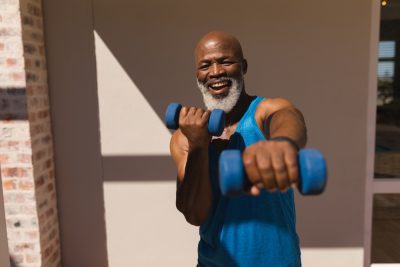Most people turn to exercise as their fountain of youth, expecting regular workouts to keep them looking and feeling decades younger. While physical activity remains one of the most effective anti-aging strategies available, certain exercise habits can backfire spectacularly. Some fitness approaches actually accelerate the aging process more dramatically than lighting up a cigarette every day.
The human body responds to exercise stress in complex ways, and when that stress becomes excessive or improperly managed, it triggers inflammatory responses that damage cells, accelerate tissue breakdown, and speed up the biological clock. Understanding these counterproductive patterns can help anyone avoid turning their health-conscious efforts into age-accelerating mistakes.
1. Extreme overtraining without adequate recovery periods
Pushing the body beyond its recovery capacity creates a cascade of aging effects that surpass the damage from tobacco use. When muscles, joints, and cardiovascular systems face relentless stress without sufficient rest, the body enters a chronic state of inflammation that accelerates cellular damage throughout every organ system.
This persistent inflammatory state elevates cortisol levels, which breaks down collagen and elastin in the skin while promoting the storage of visceral fat around vital organs. The immune system becomes compromised, making the body more susceptible to infections and slower to heal from minor injuries. Sleep quality deteriorates as the nervous system struggles to downregulate from constant high-stress states.
Overtraining syndrome manifests through persistent fatigue, declining performance despite increased effort, mood disturbances, and frequent minor illnesses. The body begins consuming its own muscle tissue for energy when pushed beyond sustainable limits, leading to a loss of lean mass that typically accompanies advanced aging. Recovery times extend dramatically, and what once required one day of rest now demands a full week.
The hormonal disruption from excessive training particularly affects growth hormone and testosterone production, both crucial for maintaining youthful characteristics. Women may experience menstrual irregularities, while men often notice decreased libido and energy. These hormonal imbalances accelerate bone density loss and muscle atrophy, mimicking the effects of premature aging.
2. High-impact exercises with poor form and technique
Repetitive high-impact movements performed with incorrect form create cumulative joint damage that ages the musculoskeletal system faster than decades of sedentary living. Each improper landing, twisted knee, or misaligned spine during exercise sends shock waves through the body that gradually wear down cartilage, ligaments, and bone structure.
Poor running form, particularly heel striking on hard surfaces, generates impact forces that travel up through the kinetic chain, affecting ankles, knees, hips, and spine. Over time, this repetitive trauma leads to chronic inflammation in joint spaces, accelerating arthritis development and reducing mobility. The body compensates for these micro-injuries by altering movement patterns, creating additional stress on secondary muscle groups and joints.
Weightlifting with improper technique compounds these issues by adding external load to compromised movement patterns. Rounded shoulders during pressing movements accelerate thoracic spine degeneration, while excessive lumbar extension during squats and deadlifts can lead to disc herniation and chronic back pain that limits future activity levels.
High-impact aerobics classes, jump training, and plyometric exercises performed without proper progression or attention to landing mechanics create similar aging effects. The connective tissues, particularly tendons and ligaments, adapt much slower than muscles to increased demands. When exercise intensity outpaces connective tissue adaptation, micro-tears accumulate faster than they can heal, leading to chronic pain conditions that persist for years.
3. Excessive cardiovascular training at maximum intensity
While moderate cardiovascular exercise provides numerous anti-aging benefits, excessive high-intensity cardio training creates oxidative stress that damages cells and accelerates aging processes throughout the body. Marathon training, extended cycling sessions, and daily high-intensity interval workouts generate massive amounts of free radicals that overwhelm the body’s natural antioxidant systems.
This oxidative damage affects every cellular component, from DNA and mitochondria to cell membranes and proteins. The mitochondria, responsible for cellular energy production, become less efficient and begin producing more reactive oxygen species. This creates a vicious cycle where energy production declines while cellular damage increases, mimicking the metabolic changes associated with advanced aging.
Excessive cardio training also elevates cortisol chronically, leading to muscle wasting, immune suppression, and accelerated skin aging. The body begins breaking down muscle tissue to fuel prolonged exercise sessions, resulting in a loss of metabolic rate and functional strength. This muscle loss typically accelerates after age 30, but excessive cardio can trigger similar effects in younger individuals.
The cardiovascular system itself suffers from chronic overuse, with some endurance athletes developing exercise-induced cardiac remodeling that resembles pathological changes seen in heart disease. Atrial fibrillation, coronary artery calcification, and other cardiac abnormalities appear more frequently in athletes who maintain extremely high training volumes for extended periods.
4. Neglecting strength training for muscle preservation
Focusing exclusively on cardiovascular exercise while ignoring resistance training accelerates age-related muscle loss and metabolic decline. After age 30, adults typically lose 3-8% of muscle mass per decade, but this process accelerates dramatically when strength training is absent from exercise routines.
Muscle tissue serves as the body’s primary metabolic engine, burning calories even at rest and helping regulate blood sugar levels. Without adequate muscle mass, the body becomes less efficient at processing nutrients and more prone to storing excess calories as fat. This metabolic slowdown mimics the changes typically associated with advanced aging and increases the risk of developing type 2 diabetes and metabolic syndrome.
Bone density also depends heavily on the mechanical stress provided by resistance training. Weight-bearing exercises stimulate bone formation and help maintain skeletal strength throughout life. Cardiovascular exercise alone provides insufficient stimulus for bone maintenance, leading to accelerated bone loss and increased fracture risk as individuals age.
The hormonal benefits of strength training extend far beyond muscle building, influencing growth hormone, testosterone, and insulin sensitivity in ways that promote youthful characteristics. Regular resistance training helps maintain these beneficial hormonal patterns, while its absence allows age-related hormonal decline to accelerate.
5. Ignoring flexibility and mobility work entirely
Abandoning stretching, mobility work, and movement quality exercises creates a cascade of compensatory patterns that age the body rapidly through restricted movement and chronic tension. As muscles tighten and joints lose range of motion, the body develops movement dysfunctions that place excessive stress on certain tissues while underutilizing others.
This imbalanced loading pattern accelerates wear and tear on overused structures while allowing underused areas to weaken and atrophy. Hip flexor tightness from prolonged sitting combined with lack of stretching creates anterior pelvic tilt, which places excessive stress on the lumbar spine and leads to chronic back pain. Similarly, tight shoulders and forward head posture accelerate cervical spine degeneration and can lead to headaches and nerve impingement.
The fascial system, which connects every structure in the body, becomes rigid and less adaptable when mobility work is neglected. This fascial restriction limits blood flow, reduces tissue hydration, and impairs the body’s ability to adapt to movement demands. Over time, these restrictions become more pronounced and difficult to reverse, leading to the hunched posture and limited mobility commonly associated with advanced aging.
Movement quality deteriorates as compensation patterns become ingrained, leading to inefficient movement that requires more energy and places greater stress on joints. Simple activities like reaching overhead, squatting down, or turning the head become limited and painful, dramatically reducing quality of life and functional independence.
The path to age-defying exercise
Creating an exercise routine that truly slows aging requires balance, progression, and attention to recovery. Moderate-intensity exercise performed consistently provides superior anti-aging benefits compared to extreme training approaches. This includes combining cardiovascular exercise, strength training, flexibility work, and adequate recovery in sustainable proportions.
The most effective anti-aging exercise programs emphasize movement quality over quantity, progressive overload rather than maximum intensity, and long-term consistency over short-term gains. By avoiding these common exercise mistakes and focusing on sustainable practices, anyone can harness the true anti-aging power of physical activity without accelerating the very processes they’re trying to prevent.

















